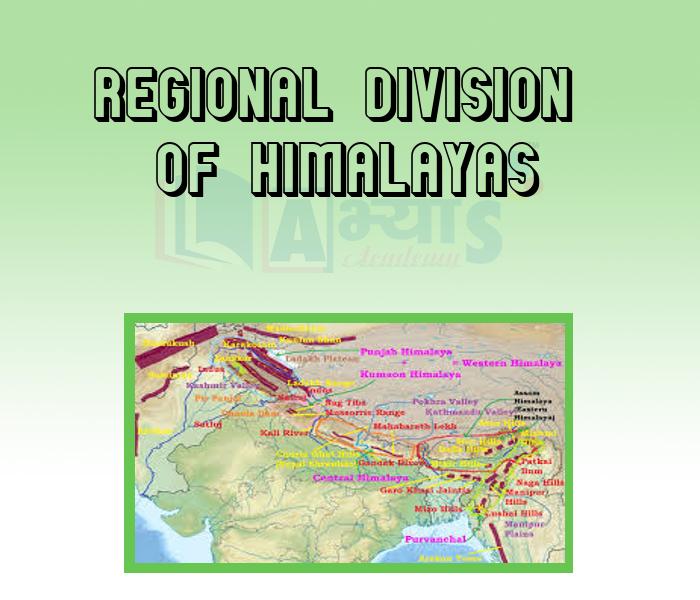Regional Division of Himalayas













Regional Division of Himalayas
The Himalayan MountainsThe Himalayas are geologically young and structurally fold mountains. They stretch over the Northern borders of India. They form an arc, covering a distance about 2400 km. Their width varies from 400 km in Kashmir to 150 km Arunachal Pradesh, These mountain ranges run in West-East direction from the Indus to the Brahmaputra Rivers. The altitudinal variations in Himalayas are greater in the Eastern half than those in the Western half. The Himalayas consist of three parallel ranges in its longitudinal extent. A number of valleys lie between these ranges.Himadri or Inner Himalayas or Great Himalayas: The Northern most range is known as the Great or Inner Himalayas or the Himadri. It has an average height of 6000 m. It contains all the prominent Himalayan peaks like Mount Everest, Kanchenjunga, Makalu, etc. Kanchenjunga is the highest peak of the Himalayas in India a height of 8598 m. Whereas the highest peak Mount Everest (8848 m) lies in Nepal. Great Himalayas are snow covered all the year round. The core of this part is posed of granite. The fold of Great Himalayas is asymmetrical in nature.Himachal or Lesser Himalayas: This range, lies to the South of the Himadri and forms the most rugged mountain system. It is composed of highly compressed rocks with height varying from 3700 to 4500 m. The average width of this range of the Himalayas is 50 km. It is composed of ranges like Pir Panjal, Dhaula Dhar. The Pir Panjal range is the longest and the most important range. They also contain the valleys having well-known hill stations in areas like Kashmir, Kangra, Kullu (in Himachal Pradesh Mussoorie, Nainital (Uttarakhand), etc.Shiwalik Range: This is the outermost range of the Himalayas with height varying between 900 and 1100 m. The average width is 10 to 50 km. They are composed of coarse sediments brought down by rivers from the main Himalayan ranges. These valleys are covered with thick gravel and alluvium. The longitudinal valleys lying between the Lesser Himalayas and Shiwaliks are known as Duns with names like Dehra Dun, Kotli Dun and Path Dun.
Regional Division of Himalayas: The Himalayas are also divided on the basis of regions from West to East. This demarcation is done by river valleys, i.e. the Indus, Satluj, Kali, Teesta and Dihang rivers, Punjab, Kumaon and Assam Himalayas: In the West, the part of Himalayas lying between Indus and Satluj has been traditionally known as Punjab Himalaya . But it is also known regionally as Kashmir and Himachal Himalaya from West to East, respectively. The part of the Himalayas lying between Satluj and Kali rivers is known as Kumaon Himalayas. The Kali and Teesta rivers demarcate the Nepal Himalayas and the part lying between Teesta and Dihang rivers is known as Assam Himalayas.
The Himalayas consist of three parallel ranges___________ , _______________ and ______________. | |||
| Right Option : B | |||
| View Explanation | |||
The word Himalaya means ‘the abode of snow’ in _________. | |||
| Right Option : A | |||
| View Explanation | |||
The Himalayas consist of ___________ parallel ranges in its longitudinal extent. | |||
| Right Option : C | |||
| View Explanation | |||
Students / Parents Reviews [10]
It was good as the experience because as we had come here we had been improved in a such envirnment created here.Extra is taught which is beneficial for future.

Eshan Arora
8thAbout Abhyas metholodology the teachers are very nice and hardworking toward students.The Centre Head Mrs Anu Sethi is also a brilliant teacher.Abhyas has taught me how to overcome problems and has always taken my doubts and suppoeted me.

Shreya Shrivastava
8thAbhyas is a complete education Institute. Here extreme care is taken by teacher with the help of regular exam. Extra classes also conducted by the institute, if the student is weak.

Om Umang
10thI have spent a wonderful time in Abhyas academy. It has made my reasoning more apt, English more stronger and Maths an interesting subject for me. It has given me a habbit of self studying

Yatharthi Sharma
10thIt has a great methodology. Students here can get analysis to their test quickly.We can learn easily through PPTs and the testing methods are good. We know that where we have to practice

Barkha Arora
10thMy experience with Abhyas academy is very good. I did not think that my every subject coming here will be so strong. The main thing is that the online tests had made me learn here more things.

Hiya Gupta
8thA marvelous experience with Abhyas. I am glad to share that my ward has achieved more than enough at the Ambala ABHYAS centre. Years have passed on and more and more he has gained. May the centre flourish and develop day by day by the grace of God.

Archit Segal
7thBeing a parent, I saw my daughter improvement in her studies by seeing a good result in all day to day compititive exam TMO, NSO, IEO etc and as well as studies. I have got a fruitful result from my daughter.

Prisha Gupta
8thIt was a good experience with Abhyas Academy. I even faced problems in starting but slowly and steadily overcomed. Especially reasoning classes helped me a lot.

Cheshta
10thMy experience was very good with Abhyas academy. I am studying here from 6th class and I am satisfied by its results in my life. I improved a lot here ahead of school syllabus.
